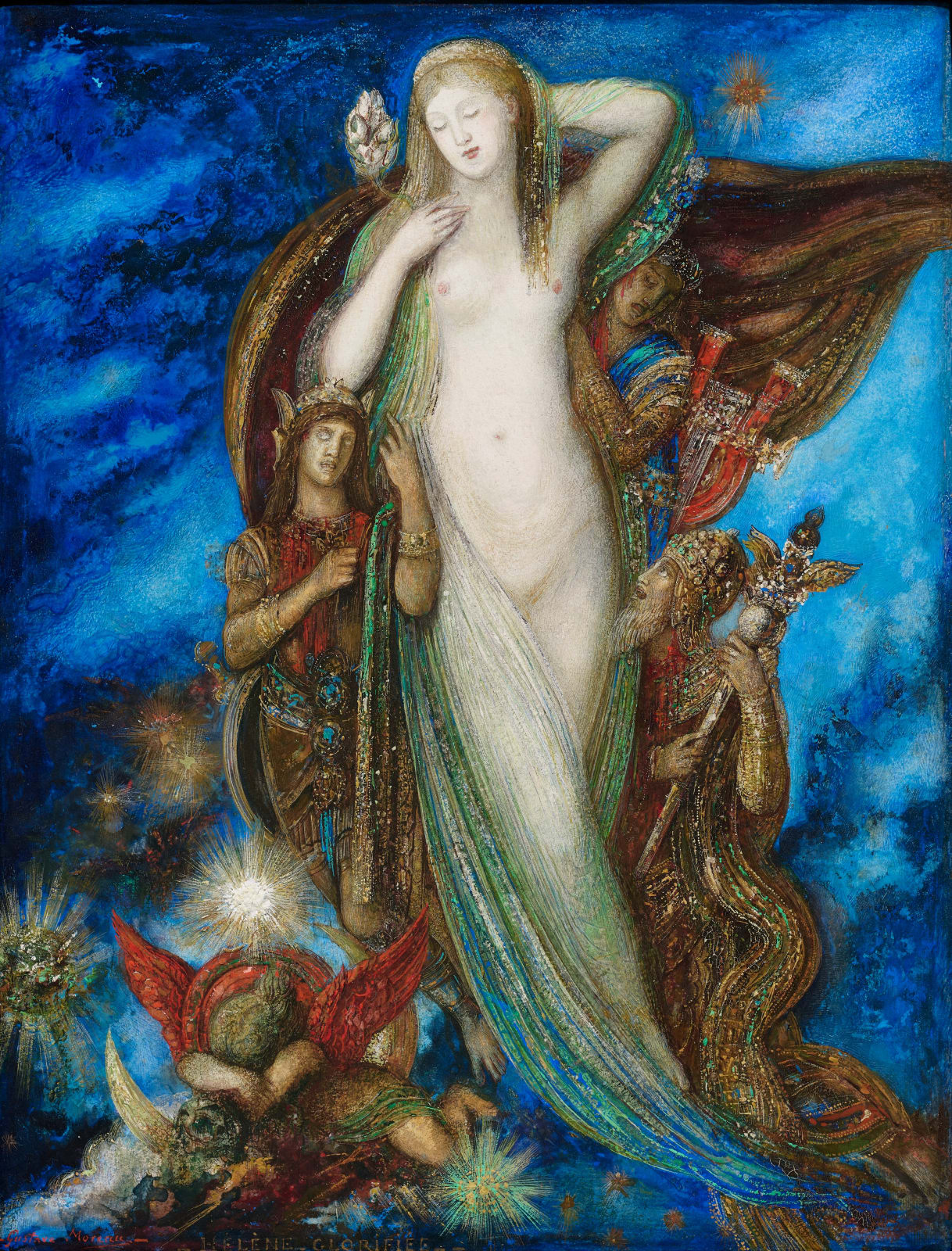Gustave Moreau (1826-1898)
At a time when mythological themes were often sentimental or formulaic, Gustave Moreau revolutionized the genre with deeply personal, fantastical, and at times unsettling interpretations. A reclusive intellectual of considerable means, Moreau spent most of his life in Paris, where his Montmartre home is now a museum, offering a window into his eccentric creative process. Exploring the inner realms of imagination over external realities, Moreau spearheaded the Symbolist movement.
Helen of Troy, celebrated as the world’s most beautiful woman in Homer’s Iliad, was Moreau’s reoccurring muse. The myth of Helen—daughter of Zeus and Leda, bride of Menelaus, King of Sparta, and cause of the Trojan War—held endless symbolic possibilities for Moreau. The discovery of Troy’s ruins by Heinrich Schliemann in 1871 revitalized interest in the fatal beauty’s story, inspiring artists already fascinated by mythology and distant places. Moreau’s Helen, in theatrical pose, is no longer merely a passive participant in the Trojan War’s tragedies; instead, she emerges as a guiltless heroine, whose beauty provoked the conflict through no fault of her own.
The present Hélène Glorifiée marks the culmination of Moreau’s exploration of Helen’s mythological and symbolic significance. The earlier prototype from 1887, now in the Musée Gustave Moreau, portrays Helen as a mysterious enchantress who captures all mankind in her spell. Drawing on Goethe’s rarely read second part of Faust (1832), Moreau depicts Helen not as a historical figure but as an ethereal archetype of beauty and inspiration.
Commissioned by the Comtesse Grefullhe, née Princess Elisabeth de Riquet de Caraman-Chimay, patron of artists such as Whistler and Rodin, and frequent visitor to Moreau’s studio, Hélène Glorifiée must have been widely admired in her Parisian Salon.[1] In a letter dated 15 May 1896, Moreau mentioned sending three unfinished watercolors to Charles Ephrussi, among them Hélène Glorifiée.[2] Delivered to the Comtesse at the Hôtel Greffruhle on rue d’Astorg by Charles Ephrussi (1849-1905), the protagonist in Edmund de Waal’s The Hare with Amber Eyes (2010), the fate of this remarkable watercolor would take a tragic turn when it was confiscated in Paris during World War II. After restitution to the art dealer George Wildenstein, the Moreau would have yet another illustrious owner: Florence Gould, a wealthy American patron, who likely identified with Helen’s mythic beauty.
Moreau’s visionary drawing reflects his fascination with the otherworldly, the macabre, and power of imagination, placing him as one of the most compelling figures of nineteenth century art. Guided by his Neo-Platonist beliefs, stressing the imperfection and impermanence of the material world, Moreau captured divine inspiration with his brush. Offering glimpses into a realm where spiritual and fatal conflicts unfold in rich symbolic terms, Moreau viewed his creations as vessels of divine vision, populated with heroes and heroines, conveying haunting portrayal of both beauty and torment.
[1] Anne de Cossé Brissac, La Comtesse Greffulhe, Paris 1991, p. 105
[2] Mathieu 1976, op.cit., p. 363
Provenance
Delivered in 1896 by the artist to Charles Ephrussi (1849-1905) for Élisabeth, Countess Greffulhe (1860-1952), ParisGeorge Wildenstein (1892-1963), Paris
Confiscated by the Einsatzstab Reichsleiter Rosenberg following the Nazi occupation of Paris, after May 1940 (No. W161)
Transferred to Neuschwanstein Castle, Germany, 15 January 1943
Returned to France, 13 November 1945, and restituted to George Wildenstein, 21 March 1947
With Wildenstein, New York
Florence Gould (1895-1983), New York
Her sale; Sotheby’s, New York, 24-25 April 1985, lot 12
Nomura & Co., Kyoto
Lecien Corporation, Kyoto
With Daniel Varenne, Geneva, 2003
Private collection, Switzerland
Their sale, Christie’s, London, 21 November 2012, lot 14
Private collection, United States
Exhibitions
Lausanne, Fondation de l'Hermitage, Chefs-d'Oeuvre de la collection Florence Gould, 1985
Zürich, Kunsthaus, Gustave Moreau Symboliste, 14 March - 25 May 1986, no. 139
Tokyo, National Museum of Western Art, Gustave Moreau, 21 March - 14 May 1995, no. 97
Kyoto, National Museum of Modern Art, 23 May - 9 July 1995
New York, David Zwirner, Endless Enigma, 12 September - 27 October 2018
Hamburg, Hamburger Kunsthalle, Femme Fatale: Gaze – Power - Gender, 9 December 2022 - 10 April 2023
Literature
Robert de Montesquiou, Un peintre lapidaire. Gustave Moreau, exh.cat. Galerie George Petit, Paris, 1906, preface, p. 27
Pierre-Louis Mathieu, Gustave Moreau: Sa vie, son oeuvre, Fribourg, 1976, no. 425, p. 363 ill.
Pierre-Louis Mathieu, Gustave Moreau: Complete edition of the finished paintings, watercolours and drawings, Oxford, 1977, no. 425
Pierre-Louis Mathieu, “Gustave Moreau et le mythe d'Hélène”, in: Gazette des Beaux-Arts, September 1985, pp. 76-80
Toni Stooss, Gustave Moreau Symboliste, Zürich 1986, no. 139, pp. 284-285
Pierre-Louis Mathieu, Gustave Moreau. Monographie et Nouveau catalogue de l'oeuvre achevé, Courbevoie (Paris), 1998, pp. 123 & 421, no. 462
Gustave Moreau, exh.cat. Grand Palais, Paris, 1998, p. 204
Gustave Moreau, Between Epic and Dream, exh.cat. Art Institute, Chicago & Metropolitan Museum of Art, New York, Princeton, 1999, p. 227
Natasha Grigorian, European Symbolism: In search of Myth (1860-1910), Oxford/New York, 2009, pp. 52, 60-62
Marie-Cécile Forest & Pierre Pinchon, Gustave Moreau: Hélène de Troie. La beauté en majesté, Musée Gustave Moreau, Paris/Lyon, exh.cat. 2012, pp. 94-95



